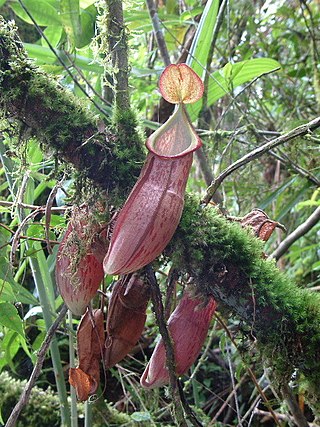Top Qs
Timeline
Chat
Perspective
Nepenthes gymnamphora
Species of pitcher plant from Indonesia From Wikipedia, the free encyclopedia
Remove ads
Nepenthes gymnamphora /nɪˈpɛnθiːz dʒɪmˈnæmfɔːrə/ is a tropical pitcher plant native to the Indonesian islands of Java and Sumatra. It has a wide altitudinal range of 600–2,800 metres (2,000–9,200 ft) above sea level.[3] There is much debate surrounding the taxonomic status of this species and the taxa N. pectinata and N. xiphioides.[4]
The specific epithet gymnamphora is derived from the Greek words gymnos (naked) and amphoreus (pitcher).[4]
Remove ads
Taxonomy
Summarize
Perspective

The N. gymnamphora group of related taxa has been variously interpreted as comprising a single extremely variable species (N. gymnamphora);[4][5][6] two distinct species, one from Java (N. gymnamphora) and one from Sumatra (N. pectinata);[7][8] or two species, one with a wide distribution covering Java and Sumatra (N. gymnamphora) and one with a very restricted range in Sumatra (N. xiphioides).[9] An additional fourth undescribed taxon, known from Mount Sorik Merapi in Sumatra, may also fall within N. gymnamphora.[4]
Nepenthes pectinata
Nepenthes pectinata[a] was described by B. H. Danser in his seminal 1928 monograph "The Nepenthaceae of the Netherlands Indies".[10] Danser's description of N. pectinata was based on material that included upper pitchers of N. singalana.[4] This was first noted in 1994 by Jan Schlauer and Joachim Nerz, who provided a lectotype for N. pectinata: Bünnemeijer 700, a specimen collected on Mount Talakmau.[8][11]
Danser mentioned another specimen in his monograph that he identified as the natural hybrid N. pectinata × N. singalana,[10] but which actually represented a pure N. singalana.[4][8]
Nepenthes pectinata has a separate conservation status of Least Concern on the IUCN Red List.[12]
Nepenthes xiphioides
Nepenthes xiphioides[b] was described by Bruce Salmon and Ricky Maulder in a 1995 issue of the Carnivorous Plant Newsletter.[9] The authors treated N. pectinata as conspecific with N. gymnamphora, and distinguished N. xiphioides from the latter based on a number of characters shown in the table below.
Remove ads
Infraspecific taxa
- Nepenthes gymnamphora var. haematamphora Miq. (1851)
- Nepenthes gymnamphora var. pectinata (Danser) Hort.Westphal (1999) in sched.
Natural hybrids
- N. bongso × N. gymnamphora[4]
- N. gymnamphora × N. mikei[9] [=N. × pangulubauensis]
- N. gymnamphora × N. ovata[9]
- N. gymnamphora × N. reinwardtiana[4]
- ? N. gymnamphora × N. rhombicaulis[5]
- N. gymnamphora × N. singalana[4]
- N. gymnamphora × N. spathulata[4]
- N. gymnamphora × N. spectabilis[4]
- N. gymnamphora × N. talangensis[4]
- ? N. gymnamphora × N. spectabilis
Notes
- a.^ Nepenthes pectinata is pronounced /nɪˈpɛnθiːz ˌpɛktɪˈnɑːtə/. The specific epithet is derived from the Latin word pectinata, meaning "comb-shaped".
- b.^ Nepenthes xiphioides is pronounced /nɪˈpɛnθiːz zɪfiːˈɔɪdiːz/. The specific epithet is derived from the Neo-Latin word xiphius (sword) and the Latin ending -oides (resembling), and refers to the long, thin teeth lining the inner margin of the peristome of this species.[9]
Remove ads
References
Further reading
External links
Wikiwand - on
Seamless Wikipedia browsing. On steroids.
Remove ads



